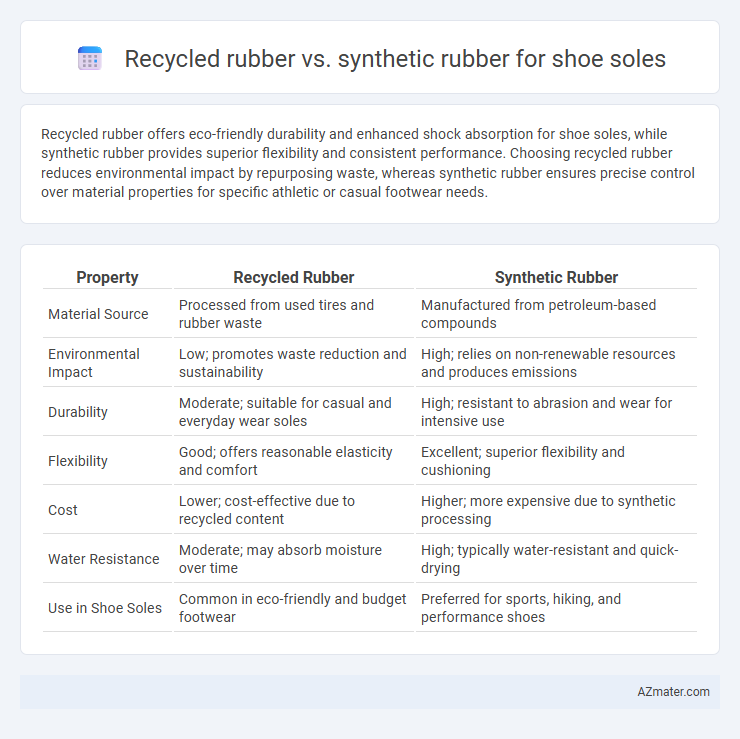Recycled rubber offers eco-friendly durability and enhanced shock absorption for shoe soles, while synthetic rubber provides superior flexibility and consistent performance. Choosing recycled rubber reduces environmental impact by repurposing waste, whereas synthetic rubber ensures precise control over material properties for specific athletic or casual footwear needs.
Table of Comparison
| Property | Recycled Rubber | Synthetic Rubber |
|---|---|---|
| Material Source | Processed from used tires and rubber waste | Manufactured from petroleum-based compounds |
| Environmental Impact | Low; promotes waste reduction and sustainability | High; relies on non-renewable resources and produces emissions |
| Durability | Moderate; suitable for casual and everyday wear soles | High; resistant to abrasion and wear for intensive use |
| Flexibility | Good; offers reasonable elasticity and comfort | Excellent; superior flexibility and cushioning |
| Cost | Lower; cost-effective due to recycled content | Higher; more expensive due to synthetic processing |
| Water Resistance | Moderate; may absorb moisture over time | High; typically water-resistant and quick-drying |
| Use in Shoe Soles | Common in eco-friendly and budget footwear | Preferred for sports, hiking, and performance shoes |
Introduction to Rubber Types in Shoe Soles
Recycled rubber in shoe soles offers eco-friendly benefits by reusing waste materials, reducing environmental impact compared to synthetic rubber derived from petrochemicals. Synthetic rubber, such as styrene-butadiene rubber (SBR) or ethylene propylene diene monomer (EPDM), provides consistent durability, flexibility, and resistance to abrasion, making it a popular choice in performance footwear. Both materials impact cushioning, grip, and longevity of shoe soles, but recycled rubber emphasizes sustainability while synthetic rubber prioritizes engineered performance.
What is Recycled Rubber?
Recycled rubber for shoe soles is made from repurposed rubber materials such as used tires, industrial rubber scraps, or manufacturing waste, which are processed and reconstituted into new sole components. This sustainable alternative reduces landfill waste and conserves natural resources compared to synthetic rubber, which is chemically engineered from petroleum-based compounds. Recycled rubber often retains durability and flexibility, making it an eco-friendly choice for footwear manufacturing without compromising performance.
What is Synthetic Rubber?
Synthetic rubber is a man-made elastomer produced through the polymerization of various petrochemicals, commonly used in shoe soles for its consistent quality, durability, and resistance to wear and tear. Unlike recycled rubber derived from repurposed tires or industrial waste, synthetic rubber offers precise control over properties like flexibility, abrasion resistance, and temperature tolerance, enhancing shoe performance. Key types include styrene-butadiene rubber (SBR) and nitrile rubber (NBR), which are engineered to meet specific functional demands in footwear manufacturing.
Material Composition and Source Differences
Recycled rubber for shoe soles is primarily derived from reclaimed natural or synthetic rubber products, such as old tires, offering an eco-friendly option by reducing waste and conserving raw materials. Synthetic rubber, including materials like styrene-butadiene rubber (SBR) or ethylene propylene diene monomer (EPDM), is chemically produced from petroleum-based polymers, providing consistent properties and enhanced durability. The material composition of recycled rubber varies based on the source and processing methods, while synthetic rubber ensures uniformity and performance tailored to specific footwear requirements.
Environmental Impact Comparison
Recycled rubber shoe soles significantly reduce landfill waste and lower carbon emissions compared to synthetic rubber, which is primarily derived from non-renewable petroleum resources. The production of synthetic rubber involves energy-intensive processes and releases volatile organic compounds, contributing to air pollution and environmental degradation. Recycled rubber, sourced from repurposed tires or industrial scrap, offers a sustainable alternative by minimizing resource extraction and promoting circular economy principles in footwear manufacturing.
Durability and Performance Analysis
Recycled rubber shoe soles exhibit high durability due to their dense composition and resistance to abrasion, making them ideal for heavy-duty use. Synthetic rubber soles offer superior flexibility and enhanced grip, providing better performance for athletic and high-mobility footwear. Performance analysis indicates that while recycled rubber excels in long-term wear resistance, synthetic rubber outperforms in cushioning and traction capabilities.
Cost Efficiency for Manufacturers
Recycled rubber offers manufacturers a cost-efficient alternative for shoe soles due to lower raw material expenses and reduced waste disposal fees compared to synthetic rubber. Synthetic rubber involves higher production costs from petrochemical sources and energy-intensive processes, increasing overall expenditure. Cost efficiency in manufacturing often favors recycled rubber as it combines durability with environmental benefits while minimizing material costs.
Comfort and Wearability Factors
Recycled rubber shoe soles offer enhanced sustainability without compromising durability, providing good shock absorption and flexibility for daily wear. Synthetic rubber soles excel in abrasion resistance and maintain consistent elasticity over time, ensuring long-lasting comfort and grip. Comparing both, recycled rubber prioritizes eco-friendly cushioning, while synthetic rubber emphasizes superior wearability and performance under varied conditions.
Consumer Preferences and Market Trends
Consumer preferences for shoe soles increasingly favor recycled rubber due to its eco-friendly attributes and durability, driving demand in sustainable footwear markets. Synthetic rubber remains popular for its consistent performance and cost-effectiveness, appealing to consumers prioritizing price and specialized athletic needs. Market trends indicate a growing shift toward recycled rubber as brands capitalize on environmental awareness and regulatory pressures promoting sustainable materials.
Conclusion: Choosing the Right Rubber for Shoe Soles
Recycled rubber offers eco-friendly advantages by reducing waste and promoting sustainability in shoe sole manufacturing, while synthetic rubber provides superior durability, flexibility, and resistance to wear. Selecting the right rubber depends on prioritizing environmental impact versus performance needs, with recycled rubber ideal for environmentally conscious brands and synthetic rubber suited for high-performance footwear. Balancing these factors ensures optimal functionality and aligns with consumer values in shoe sole materials.

Infographic: Recycled rubber vs Synthetic rubber for Shoe sole
 azmater.com
azmater.com